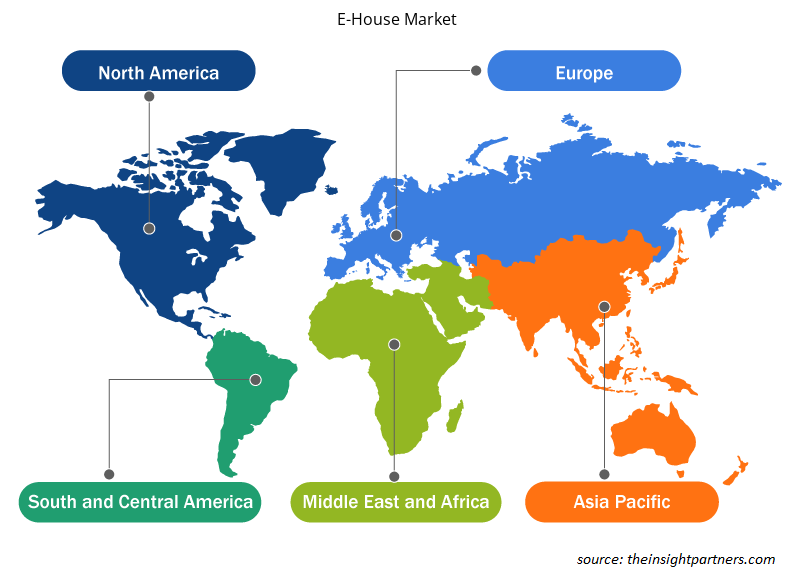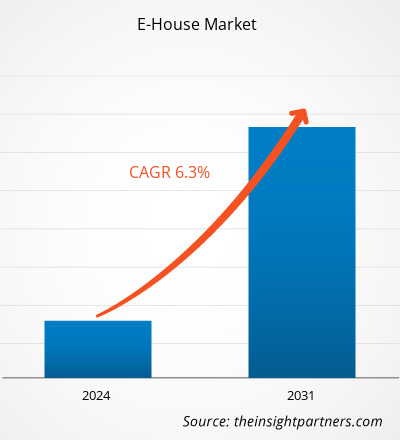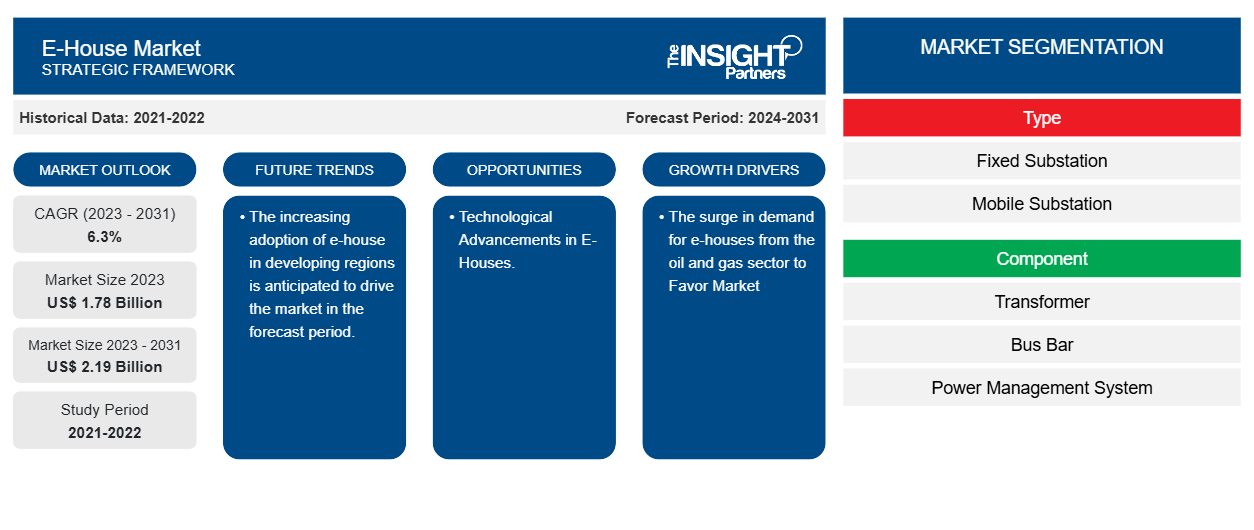من المتوقع أن يصل حجم سوق المنازل الكهربائية إلى 2.91 مليار دولار أمريكي بحلول عام 2031 من 1.78 مليار دولار أمريكي في عام 2023. ومن المتوقع أن يسجل السوق معدل نمو سنوي مركب بنسبة 6.3٪ خلال الفترة 2023-2031. ومن المرجح أن تكون سهولة التركيب والفعالية من حيث التكلفة والمرونة في المنازل الكهربائية والزيادة في الطلب على المنازل الكهربائية من قطاع النفط والغاز هي المحركات والاتجاهات الرئيسية لسوق المنازل الكهربائية.
تحليل سوق E-House
يشهد سوق المنازل الإلكترونية نموًا كبيرًا على مستوى العالم. ويعزى هذا النمو إلى سهولة التركيب والفعالية من حيث التكلفة والمرونة التي تتميز بها المنازل الإلكترونية والزيادة الكبيرة في الطلب على المنازل الإلكترونية من قطاع النفط والغاز. وعلاوة على ذلك، من المتوقع أن يوفر تبني المنازل الإلكترونية في المناطق النامية والتقدم التكنولوجي العديد من الفرص في السنوات القادمة.
نظرة عامة على سوق E-House
تعد المنازل الكهربائية عبارة عن محطات فرعية مسبقة الصنع تستخدم كمراكز توزيع للطاقة. وتوفر مثل هذه المحطات الفرعية التي يتم تجميعها في حاويات غرفًا لمعدات التوزيع حسب الحاجة. وبالنسبة للتطبيقات الخاصة مثل مراكز البيانات، يمكن توفير منصات للنشر السريع. ويتم تركيب المنازل الكهربائية المتنقلة على مقطورات كمحطات فرعية محمولة.
قم بتخصيص هذا التقرير ليناسب متطلباتك
ستحصل على تخصيص لأي تقرير - مجانًا - بما في ذلك أجزاء من هذا التقرير، أو تحليل على مستوى الدولة، وحزمة بيانات Excel، بالإضافة إلى الاستفادة من العروض والخصومات الرائعة للشركات الناشئة والجامعات
- احصل على أهم اتجاهات السوق الرئيسية لهذا التقرير.ستتضمن هذه العينة المجانية تحليلاً للبيانات، بدءًا من اتجاهات السوق وحتى التقديرات والتوقعات.
محركات وفرص سوق E-House
ارتفاع الطلب على المنازل الإلكترونية من قطاع النفط والغاز لصالح السوق.
يتم تركيب وحدات E-Houses المتنقلة على مقطورات كمحطات فرعية محمولة. يمكن لجميع أنواع وحدات E-Houses حل تحديات المشروع المختلفة ودعم أهداف الاستدامة المشتركة. يتم نشر وحدات E-Houses في منشآت النفط والغاز في المنبع والمنتصف والمصب. وهي تحتوي على معدات لتوزيع الطاقة وأنظمة التحكم والأجهزة الضرورية لاستخراج ومعالجة ونقل النفط والغاز. تُستخدم وحدات E-Houses على نطاق واسع في صناعة النفط والغاز والتعدين وبشكل متكرر أكثر لتثبيت المعدات في قطاعات أخرى. وبالتالي، بالنظر إلى المعايير المذكورة أعلاه، فإن الارتفاع في الطلب على وحدات E-Houses من قطاع النفط والغاز هو المحرك للسوق.
التقدم التكنولوجي في المنازل الإلكترونية.
من المتوقع أن يؤدي التقدم التكنولوجي في المنازل الإلكترونية إلى دفع السوق في السنوات القادمة. لقد شهد السوق تقدمًا تكنولوجيًا كبيرًا في السنوات الأخيرة. هذه التطورات مدفوعة بالحاجة إلى حلول طاقة أكثر كفاءة وموثوقية وقابلية للتكيف في مجموعة متنوعة من القطاعات. تقدم شركات مختلفة حلولًا منزلية إلكترونية متقدمة تقنيًا. على سبيل المثال، تظل Kontrolmatik في طليعة التطورات التكنولوجية في تصميم المنازل الإلكترونية. تدمج الشركة أحدث التقنيات الذكية والحلول الموفرة للطاقة وأنظمة التحكم المتقدمة لتوفير حلول متطورة لعملائها. وبالتالي، من المتوقع أن يؤدي التقدم التكنولوجي في المنازل الإلكترونية إلى دفع نمو السوق في السنوات القادمة.
تحليل تجزئة تقرير سوق المنازل الإلكترونية
إن القطاعات الرئيسية التي ساهمت في استخلاص تحليل سوق المنزل الإلكتروني هي النوع والمكونات والتطبيقات.
- بناءً على النوع، يتم تقسيم سوق المحطات الكهربائية المنزلية إلى محطات فرعية ثابتة ومحطات فرعية متنقلة. ومن المتوقع أن يحظى قطاع المحطات الفرعية الثابتة بحصة سوقية كبيرة خلال فترة التوقعات.
- بناءً على المكونات، يتم تقسيم سوق E-house إلى المحولات وقضبان التوزيع وأنظمة إدارة الطاقة ومحركات التردد المتغير ومعدات التبديل وتكييف الهواء والتدفئة وغيرها. ومن المتوقع أن يحتفظ قطاع المحولات بحصة سوقية كبيرة في فترة التوقعات.
- من حيث التطبيق، يتم تقسيم السوق إلى قطاع صناعي وقطاع مرافق. ومن المتوقع أن تستحوذ قطاع المرافق على حصة سوقية كبيرة خلال فترة التوقعات.
تحليل حصة سوق E-House حسب المنطقة الجغرافية
يتم تقسيم النطاق الجغرافي لتقرير سوق المنزل الإلكتروني بشكل أساسي إلى خمس مناطق: أمريكا الشمالية، ومنطقة آسيا والمحيط الهادئ، وأوروبا، والشرق الأوسط وأفريقيا، وأمريكا الجنوبية والوسطى.
سيطرت أمريكا الشمالية على سوق المنازل الإلكترونية. وتنقسم سوق أمريكا الشمالية إلى الولايات المتحدة وكندا والمكسيك. وقد أدت اتجاهات تبني التكنولوجيا العالية في مختلف الصناعات في منطقة أمريكا الشمالية إلى تغذية نمو سوق المنازل الإلكترونية. ومن المتوقع أن تؤدي عوامل مثل زيادة تبني الأدوات الرقمية والإنفاق التكنولوجي المرتفع من قبل الوكالات الحكومية إلى دفع نمو سوق المنازل الإلكترونية في أمريكا الشمالية. وعلاوة على ذلك، فإن التركيز القوي على البحث والتطوير في الاقتصادات المتقدمة في الولايات المتحدة وكندا يجبر اللاعبين في أمريكا الشمالية على جلب حلول متقدمة تقنيًا إلى السوق. بالإضافة إلى ذلك، يوجد في الولايات المتحدة عدد كبير من اللاعبين في سوق المنازل الإلكترونية الذين يركزون بشكل متزايد على تطوير حلول مبتكرة. كل هذه العوامل تساهم في نمو سوق المنازل الإلكترونية في المنطقة.
رؤى إقليمية حول سوق المنازل الإلكترونية
لقد قام المحللون في Insight Partners بشرح الاتجاهات والعوامل الإقليمية المؤثرة على سوق E-House طوال فترة التوقعات بشكل شامل. يناقش هذا القسم أيضًا قطاعات سوق E-House والجغرافيا في جميع أنحاء أمريكا الشمالية وأوروبا ومنطقة آسيا والمحيط الهادئ والشرق الأوسط وأفريقيا وأمريكا الجنوبية والوسطى.

- احصل على البيانات الإقليمية المحددة لسوق المنازل الإلكترونية
نطاق تقرير سوق E-House
| سمة التقرير | تفاصيل |
|---|---|
| حجم السوق في عام 2023 | 1.78 مليار دولار أمريكي |
| حجم السوق بحلول عام 2031 | 2.19 مليار دولار أمريكي |
| معدل النمو السنوي المركب العالمي (2023 - 2031) | 6.3% |
| البيانات التاريخية | 2021-2022 |
| فترة التنبؤ | 2024-2031 |
| القطاعات المغطاة | حسب النوع
|
| المناطق والدول المغطاة | أمريكا الشمالية
|
| قادة السوق وملفات تعريف الشركات الرئيسية |
|
كثافة اللاعبين في سوق E-House: فهم تأثيرها على ديناميكيات الأعمال
يشهد سوق المنازل الإلكترونية نموًا سريعًا، مدفوعًا بالطلب المتزايد من جانب المستخدم النهائي بسبب عوامل مثل تفضيلات المستهلكين المتطورة والتقدم التكنولوجي والوعي المتزايد بفوائد المنتج. ومع ارتفاع الطلب، تعمل الشركات على توسيع عروضها والابتكار لتلبية احتياجات المستهلكين والاستفادة من الاتجاهات الناشئة، مما يؤدي إلى زيادة نمو السوق.
تشير كثافة اللاعبين في السوق إلى توزيع الشركات أو المؤسسات العاملة في سوق أو صناعة معينة. وهي تشير إلى عدد المنافسين (اللاعبين في السوق) الموجودين في مساحة سوق معينة نسبة إلى حجمها أو قيمتها السوقية الإجمالية.
الشركات الرئيسية العاملة في سوق E-House هي:
- شركة أيه بي بي المحدودة
- ايتون
- شركة بيكر لأنظمة التعدين
- شركة شنايدر الكتريك
- شركة سيمنز ايه جي
- ويج
إخلاء المسؤولية : الشركات المذكورة أعلاه ليست مرتبة بأي ترتيب معين.

- احصل على نظرة عامة على أهم اللاعبين الرئيسيين في سوق E-House
أخبار سوق العقارات الإلكترونية والتطورات الأخيرة
يتم تقييم سوق المنازل الإلكترونية من خلال جمع البيانات النوعية والكمية بعد البحث الأولي والثانوي، والذي يتضمن منشورات الشركات المهمة وبيانات الجمعيات وقواعد البيانات. فيما يلي بعض التطورات في سوق المنازل الإلكترونية:
- تعاونت شركة Hartek Power مع شركة TP Western Odisha Distribution Limited (TPWODL)، وهي مشروع مشترك بين شركة TATA Power وشركة Odisha Distribution Limited، لإنشاء محطتين فرعيتين جديدتين لتوليد الطاقة من نوع الحاويات من نوع E-house بقدرة 33/11 كيلو فولت بقيمة 2.99 مليون دولار أمريكي على أساس تسليم المفتاح. (المصدر: موقع شركة Hartek Power على الإنترنت، أغسطس 2023)
تقرير سوق E-House والتغطية والنتائج المتوقعة
يوفر تقرير "حجم سوق E-House والتوقعات (2021-2031)" تحليلاً مفصلاً للسوق يغطي المجالات التالية:
- حجم سوق المنازل الإلكترونية وتوقعاته على المستويات العالمية والإقليمية والوطنية لجميع قطاعات السوق الرئيسية التي يغطيها النطاق
- اتجاهات سوق المنازل الإلكترونية بالإضافة إلى ديناميكيات السوق مثل المحركات والقيود والفرص الرئيسية
- تحليل مفصل لقوى PEST/Porter الخمس وSWOT
- تحليل سوق E-house الذي يغطي اتجاهات السوق الرئيسية والإطار العالمي والإقليمي واللاعبين الرئيسيين واللوائح والتطورات الأخيرة في السوق
- تحليل المشهد الصناعي والمنافسة الذي يغطي تركيز السوق، وتحليل خريطة الحرارة، واللاعبين البارزين، والتطورات الأخيرة في سوق الأجهزة الإلكترونية.
- ملفات تعريف الشركة التفصيلية
- التحليل التاريخي (سنتان)، سنة الأساس، التوقعات (7 سنوات) مع معدل النمو السنوي المركب
- تحليل PEST و SWOT
- حجم السوق والقيمة / الحجم - عالمي، إقليمي، بلد
- الصناعة والمنافسة
- مجموعة بيانات إكسل
التقارير الحديثة
شهادات العملاء
سبب الشراء
- اتخاذ قرارات مدروسة
- فهم ديناميكيات السوق
- تحليل المنافسة
- رؤى العملاء
- توقعات السوق
- تخفيف المخاطر
- التخطيط الاستراتيجي
- مبررات الاستثمار
- تحديد الأسواق الناشئة
- تحسين استراتيجيات التسويق
- تعزيز الكفاءة التشغيلية
- مواكبة التوجهات التنظيمية























 احصل على عينة مجانية ل - سوق إي هاوس
احصل على عينة مجانية ل - سوق إي هاوس